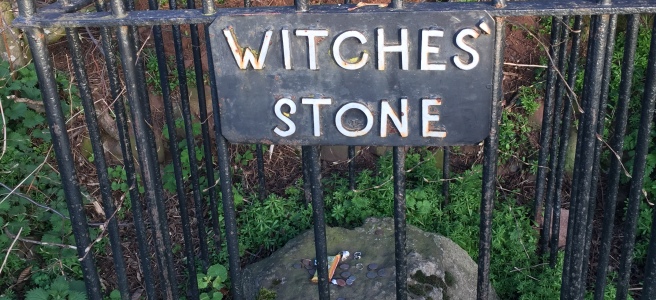Spott, a tiny village in East Lothian, just about 40 minutes drive from Edinburgh, holds the dubious distinction of playing host to the last executions of witches in Scotland in the 17th and 18th centuries.
I drive out that way every couple weeks to visit E. and S. and we explore the back laneways of the area. They take me past the Spott spot where the Witches’ Stone rests quietly at the side of the road, long grass shielding it from curious eyes. It marks where Marion Lillie, the Rigwoodie Witch, was burnt about 1698 and serves to commemorate other ‘witches’ who were hunted in this district. The stone, set back from the roadside in a hawthorn hedge, is a simple marker to remind the occasional passer-by of the madness of the witch-hunts. ‘Rigwoodie’ is the old Scots word for thin and bony. I wonder if this was one of the reasons people were frightened of Marion Lillie – because she looked different, maybe a little scary in her angularity.
She wasn’t the only one to be branded a witch and put to death around here – far from it. Many other alleged witches were executed at Spott before Marion’s demise. E. tells me the story of one particular coven. James VI and his bride, Anne of Denmark, were to sail back across the North Sea. News reached the King that a coven of local ‘witches’ had summoned violent storms making the newly-weds’ journey back from Denmark all the more treacherous. Of course, the North Sea is often stormy in October, but the King – in all wisdom – decided to blame the foul weather squarely on a group of women. Who knows what their transgressions had been within the local community, but they confessed, under torture, to conjuring up the tempest, and the consequences were the worst imaginable! He came back, rounded them up, and burned the lot of them. Did they curse the King and his new wife, drumming up high winds in an attempt to drown them? Or did one woman look sideways at a neighbour in the street, another express an incorrect opinion, and a third break away from the tribe by doing things differently? These days we’ve (hopefully) outgrown naming people as witches but it still doesn’t take much to be branded ‘eccentric’, ‘peculiar’ and cast out in an age of homogeneity.
Irishman, John Millington Synge wrote his acclaimed play, “The Playboy of the Western World” in 1907. In American he and his play were largely feted. Back in Ireland, his celebrity was of a different hue; he was shunned, with protests outside The Abbey theatre when the play had its short run there. Offensive and an insult to Ireland – was the general opinion of the day; Synge had transgressed. The public were disgusted by a play which appeared to celebrate patricide and denigrate the rural Irish. To say that Synge was hurt by the reception at home, that it cut him deeply, is a masterful understatement. Read his poem, “The Curse” in which he responds to one particularly disapproving review and you’ll get a feel for what was stirred up in him. I think he felt as hunted and ostracised as the witches of East Lothian; the criticism he received drew forth nothing short of witchcraft.
‘The Curse’, by J. M. Synge
To a sister of an enemy of the author’s who disapproved of ‘The Playboy’
“Lord, confound this surly sister,
Blight her brow with blotch and blister,
Cramp her larynx, lung, and liver,
In her guts a galling give her.
Let her live to earn her dinners
In Mountjoy with seedy sinners:
Lord, this judgment quickly bring,
And I’m your servant, J. M. Synge.”
Had Synge lived in East Lothian in the 17th Century, such writings would surely have been his death sentence. Happy Hallowe’en to you all, and go easy on the spells and curses!

